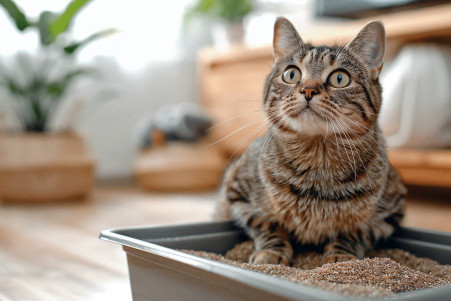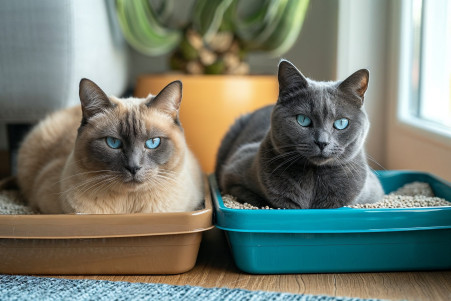How Much Litter Should You Put in Your Cat's Litter Box? Balancing Litter Quantity
17 April 2024 • Updated 16 April 2024

There are a lot of things to consider when you're trying to figure out how much litter to put in your cat's litter box, including the size of the box, the type of litter, and your cat's personal habits. That said, you should aim to fill the box with 2-3 inches of litter if you're using a standard clumping clay litter, and 3-4 inches if you're using a lightweight litter, such as one made from wheat or corn. Of course, you may need to adjust these amounts based on the size of the box and how many cats are using it.
We'll look at everything from studies that have been published in veterinary journals to surveys of cat owners to help you figure out the best depth to fill your cat's litter box. By exploring how the depth of the litter impacts things like odor, how easy it is for your cat to dig and cover their waste, and how much work you'll have to put into maintaining the box, you'll be able to make sure that your cat's litter box is set up in a way that meets their needs and your own. So let's jump into what the experts have to say.
How much litter should you put in your cat's litter box?
Factors to Keep in Mind for Litter Box Setup
In addition to the type of litter, there are several other things to consider when determining the ideal litter depth. For example, larger litter boxes will require more litter to maintain the 2-3 inch depth for clumping clay litters or 3-4 inches for lightweight litters. If you have a multi-cat household or a single-cat household with a lot of litter box traffic, you may need to add more litter to accommodate the extra use between cleanings.
You also need to consider your cat's personal preferences. Some cats may prefer a deeper litter box to dig and bury their waste, according to Catster, while others may be fine with a shallower litter box. The type of litter you use will also affect the ideal litter depth. For example, clumping litters can be scooped more easily when they're at the right depth, while non-clumping litters will require more litter to be effective.
In the end, the ideal litter depth will depend on your cat's individual needs and preferences. Some cats may not use the litter box if the litter is too deep, while others may not use it if the litter is too shallow. Pay attention to your cat's behavior and adjust the litter depth as needed to ensure that your cat is comfortable, clean, and using the litter box consistently. When you find the right litter depth, you'll be able to control odors and make litter box maintenance a breeze.
How Deep Should the Litter Be to Control Odor?
The depth of the litter in the box is also important for controlling odor. According to Purina, the ideal depth for non-clumping litters is 2-3 inches, while clumping litters should be 3-4 inches deep. This allows cats to cover their waste effectively, which is important for controlling odor and making it easier for you to scoop the litter.
Clumping litter is especially effective at controlling odor when it's used at the right depth because it absorbs moisture and locks in odor more quickly. As NewsWatchTV explains, clumping litters also make it easier to scoop the litter than non-clumping litters, which need to be completely replaced more often.
That said, some cats, especially those that are particularly sensitive to odor or that tend to dig a lot, may benefit from a slightly deeper litter bed of 3-4 inches. This will give them more space to cover their waste and help contain odors. However, you should monitor your cat's litter box habits and adjust the depth of the litter as needed to ensure that the box is always a welcoming place for your cat to go.
Switching to a Different Litter Type and Depth
If you want to switch to a different litter type or depth, you should do so slowly so as not to startle or stress your cat. According to Modkat, the best way to do this is to mix a small amount of the new litter with the old and then gradually increase the amount over the course of 1-2 weeks. This will help your cat get used to the new smell and texture without overwhelming them.
As suggested by We Know Pets, you should start with a 25/75 mix of new to old litter and then increase it to 50/50, 75/25, and finally 100% new litter. You can also help your cat get used to the new litter by rewarding them with treats when they use the litter box during the transition.
When choosing a new litter, think about things like your cat's preferences for scent, how well the litter clumps, and any health issues your cat may have. Purina notes that you should keep the litter box in the same place so that you don't disrupt your cat's routine. You should also watch your cat's behavior carefully and be ready to slow down or switch to a different type of litter if your cat seems reluctant or avoids the litter box. However, if you're patient and take your time, you can successfully switch your cat to a new litter that works for them.
How Often Should You Clean the Litter Box?
Keeping the litter box clean and well-maintained is important for odor control and ensuring your cat will use it regularly. Purina recommends scooping out waste once or twice a day, especially in a multi-cat household. This will help keep odors to a minimum and ensure the litter stays fresh between cleanings.
How often you need to replace the entire litter will depend on the type of litter you use. Purina suggests changing non-clumping litter at least once a week for one cat and every few days for multiple cats. Clumping litters can go 2-4 weeks for one cat and should be changed once a week for multiple cats. Other signs that it's time to change the litter include a strong smell, clumps in the litter, and the litter feeling damp, according to Litter-Robot.
When you do a full litter box cleaning, Purina says to throw away all of the old litter, wash the box with a mild soap or detergent, and let it dry completely before refilling it with 2-3 inches of non-clumping or 3-4 inches of clumping litter. Sticking to this schedule will help you keep odors under control and ensure your cat feels comfortable using their litter box.
Conclusion: How to Find the Right Litter Depth for Your Cat
When it comes to finding the right litter depth for your cat’s litter box, there are a few things to keep in mind. The first is the size of the litter box. In general, larger litter boxes will require more litter. That said, most experts agree that 2-3 inches of litter is the right amount for clumping clay litters, while 3-4 inches is best for lightweight litters like wheat or corn. Preventive Vet also suggests that you follow the “n+1 rule” when it comes to the number of litter boxes, meaning you should have one more box than you have cats in your home.
The type of litter you’re using will also play a role in how deep your litter should be. Clumping litters will be easier to scoop at the recommended depths than non-clumping litters. Vistagato notes that clumping clay litters are known for their absorbency and odor control, while non-clumping litters will need to be changed more often. Other things to consider include the number of cats using the box and their individual habits, including how much they dig and how much they kick litter.
In the end, it’s important to pay attention to your cat’s behavior and adjust the litter depth as needed to ensure that they have a clean, comfortable place to go to the bathroom. By keeping the litter at the right level, you can make sure that you’re controlling odors, making it easy to scoop, and ensuring that your cat is happy and willing to use their litter box.


